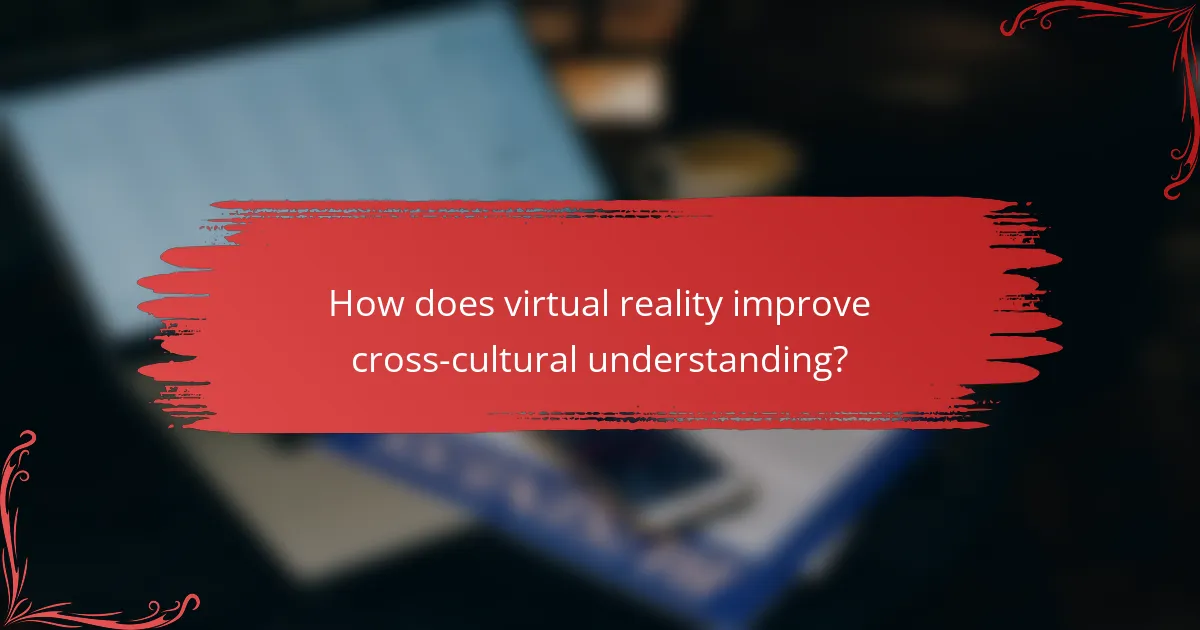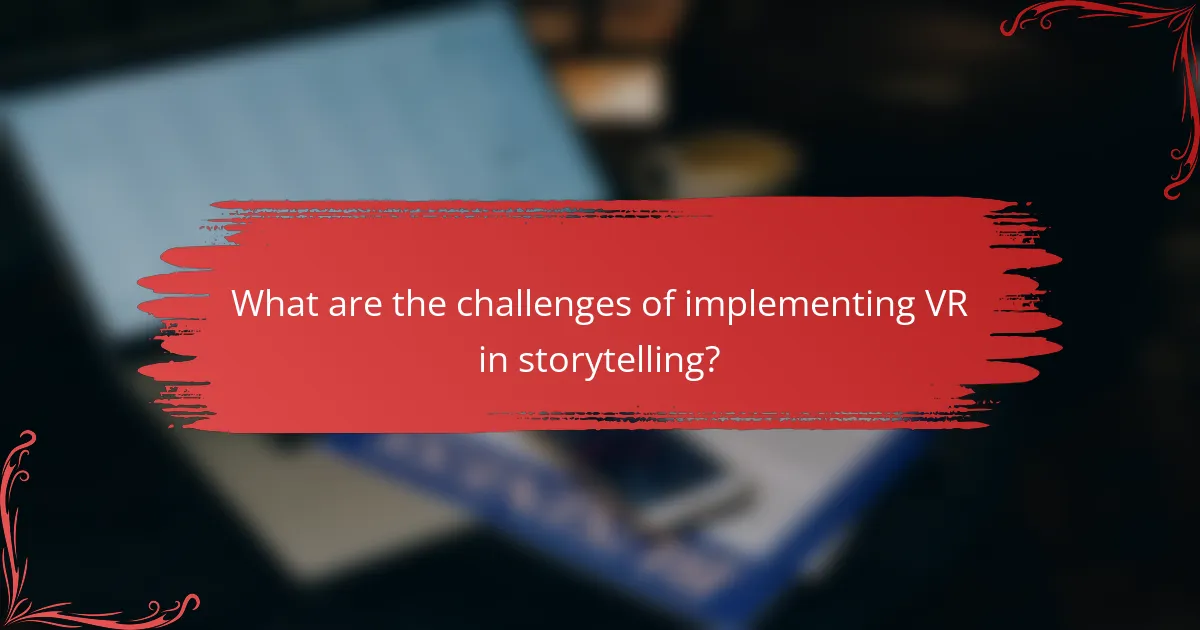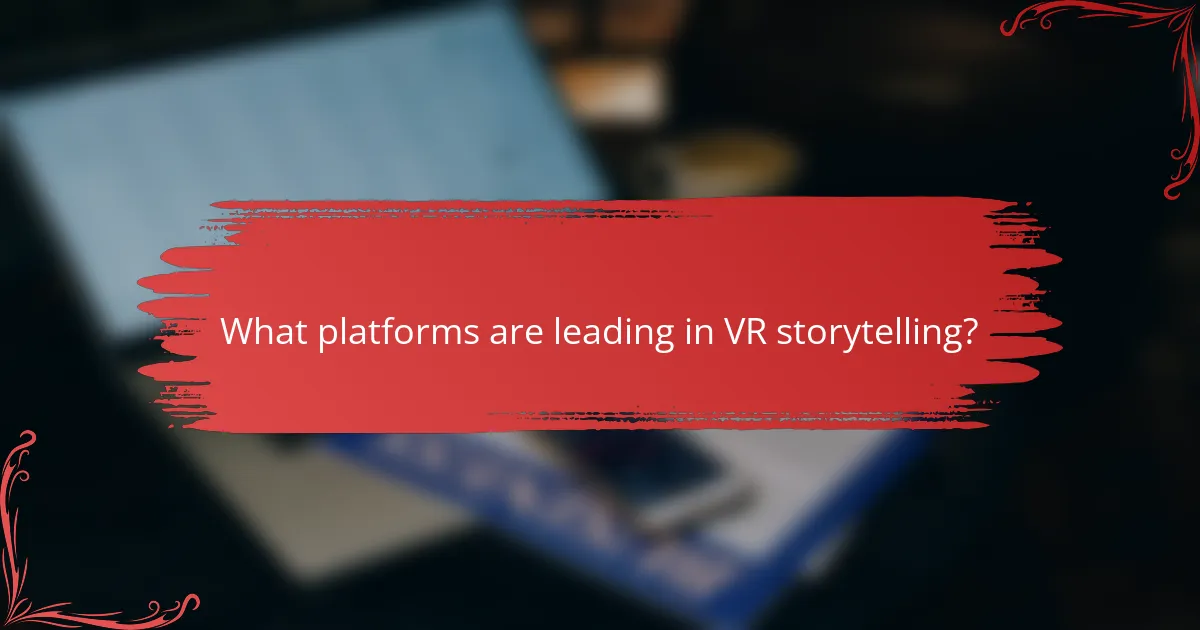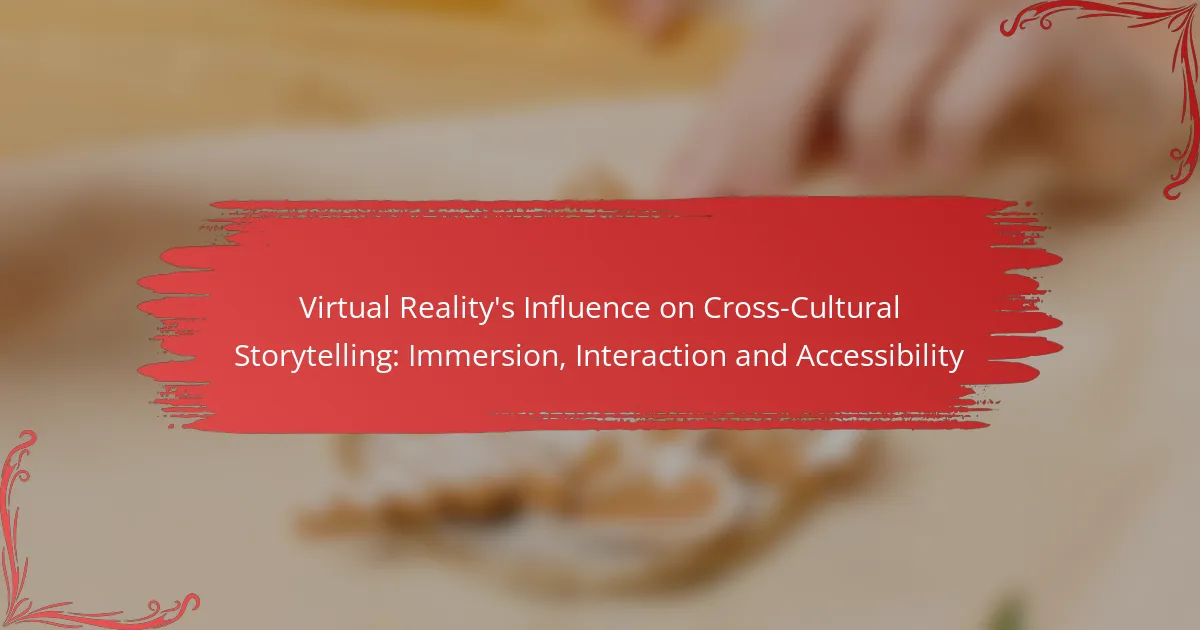Virtual reality (VR) is transforming cross-cultural storytelling by offering immersive experiences that foster emotional connections and understanding of diverse narratives. This innovative technology enables users to interact with different cultures in a meaningful way, enhancing personal engagement and appreciation for global perspectives.

How is virtual reality transforming storytelling across cultures?
Virtual reality (VR) is revolutionizing storytelling by providing immersive experiences that engage users in diverse cultural narratives. This technology allows for deeper emotional connections and understanding of different perspectives, enhancing the way stories are told and experienced globally.
Enhanced immersion through VR technology
VR technology enhances immersion by creating realistic environments that users can explore. This sensory engagement allows individuals to feel as if they are part of the story, rather than just passive observers. For example, VR experiences can transport users to historical settings or cultural festivals, making them feel the atmosphere and emotions of those moments.
Moreover, the use of 360-degree video and spatial audio further enriches the storytelling experience, allowing users to interact with their surroundings. This level of immersion can lead to a more profound understanding of cultural narratives, as users can experience the sights and sounds of different cultures firsthand.
Interactive narratives in diverse cultures
Interactive narratives in VR enable users to make choices that affect the storyline, fostering a sense of agency. This interactivity is particularly effective in cross-cultural storytelling, as it allows users to explore various outcomes based on different cultural values and decisions. For instance, a VR experience might let users navigate moral dilemmas faced by characters from different backgrounds.
By engaging with these narratives, users can gain insights into the complexities of cultural identities and traditions. This approach not only entertains but also educates, encouraging empathy and understanding among diverse audiences.
Accessibility improvements for global audiences
VR technology is making storytelling more accessible to global audiences by breaking down language and geographical barriers. Many VR experiences now include multilingual options and subtitles, allowing users from different linguistic backgrounds to engage with the content. This inclusivity is crucial for sharing cultural stories with a wider audience.
Additionally, advancements in VR hardware and software are lowering costs and improving usability, making it easier for creators from various regions to produce and share their stories. As VR becomes more prevalent, it is essential for developers to prioritize accessibility features to ensure that everyone can participate in these immersive experiences.

What are the key benefits of using virtual reality in storytelling?
Virtual reality (VR) enhances storytelling by creating immersive experiences that engage users on a deeper emotional level. It allows for interactive narratives that can adapt to individual choices, making stories more personal and impactful.
Increased engagement and emotional connection
VR storytelling captivates audiences by placing them directly within the narrative, fostering a sense of presence that traditional media cannot achieve. This immersion can lead to stronger emotional responses, as users feel they are part of the story rather than mere observers.
For example, VR experiences that simulate real-life scenarios, such as historical events or personal journeys, can evoke empathy and understanding in ways that text or video alone cannot. This heightened engagement can lead to increased retention of the story’s themes and messages.
Broader cultural representation in narratives
Virtual reality offers a unique platform for diverse cultural narratives, allowing creators from various backgrounds to share their stories authentically. By immersing users in different cultural contexts, VR can promote understanding and appreciation of global perspectives.
Developers can design experiences that reflect local customs, languages, and traditions, making stories more relatable and enriching for a wider audience. This approach not only broadens representation but also encourages collaboration among creators from different cultural backgrounds, leading to richer storytelling.

How does virtual reality improve cross-cultural understanding?
Virtual reality (VR) enhances cross-cultural understanding by providing immersive experiences that allow users to engage with diverse cultures in a direct and impactful way. Through VR, individuals can explore different environments, traditions, and narratives, fostering a deeper appreciation and awareness of cultural differences.
Experiential learning through immersive environments
Immersive environments in VR facilitate experiential learning by placing users in realistic settings where they can interact with cultural elements. For example, a VR simulation of a traditional Japanese tea ceremony allows participants to learn about the customs and significance of the practice while actively engaging in the process. This hands-on approach can lead to better retention of knowledge compared to traditional learning methods.
Additionally, VR can simulate historical events or significant cultural festivals, enabling users to experience these moments firsthand. By stepping into these environments, learners can gain insights into the values and beliefs that shape different cultures, making the learning experience more impactful.
Facilitating empathy via shared experiences
VR has the unique ability to facilitate empathy by allowing users to share experiences that are often foreign to them. When individuals inhabit the perspectives of others, they can better understand the emotions and challenges faced by people from different backgrounds. For instance, a VR experience that portrays the life of a refugee can evoke strong emotional responses, fostering a sense of connection and compassion.
Moreover, shared VR experiences can be used in educational settings to promote discussions about cultural differences and social issues. By engaging in these shared narratives, participants can develop a more nuanced understanding of global challenges, ultimately leading to greater cross-cultural dialogue and collaboration.

What are the challenges of implementing VR in storytelling?
Implementing virtual reality (VR) in storytelling presents several challenges, primarily due to high production costs and technological barriers. These obstacles can hinder the creation and accessibility of immersive narratives that engage diverse audiences.
High production costs for quality content
Creating high-quality VR content often requires significant financial investment. This includes expenses for advanced hardware, software licenses, and skilled personnel, which can lead to production budgets in the tens of thousands to millions of dollars.
For independent creators or smaller studios, these costs can be prohibitive. As a result, many may opt for simpler, less immersive experiences that do not fully leverage VR’s potential, limiting the richness of storytelling.
Technological barriers for creators and audiences
Technological barriers can impede both creators and audiences from fully engaging with VR storytelling. Creators may struggle with the complexity of VR development tools, which often require specialized knowledge and training.
On the audience side, access to VR hardware can be a significant barrier. Many potential users may not own the necessary devices, such as VR headsets, which can range from a few hundred to over a thousand dollars. This limits the reach of VR stories to a smaller, more affluent demographic.

What platforms are leading in VR storytelling?
Several platforms are at the forefront of virtual reality storytelling, each offering unique features and experiences. Oculus Story Studio, Google Spotlight Stories, and Within Unlimited are notable for their innovative approaches to immersive narratives.
Oculus Story Studio
Oculus Story Studio was a pioneer in creating narrative-driven VR experiences, focusing on emotional storytelling through immersive environments. Their projects, such as “Henry,” showcase how VR can evoke feelings and connect audiences with characters in a way traditional media cannot.
When using Oculus Story Studio, creators should consider the importance of user interaction and emotional engagement. Effective VR storytelling often requires balancing visual elements with sound design to enhance the overall experience.
Google Spotlight Stories
Google Spotlight Stories emphasizes interactive storytelling by allowing viewers to explore narratives from multiple angles. This platform features animated shorts that encourage audience participation, making the viewer an integral part of the story.
For creators, it’s essential to design narratives that are not only visually captivating but also allow for exploration. This could involve branching storylines or interactive elements that respond to viewer choices, enhancing immersion and engagement.
Within Unlimited
Within Unlimited focuses on high-quality storytelling through immersive experiences that often blend documentary and narrative styles. The platform hosts a variety of content, from artistic pieces to educational narratives, making it versatile for different audiences.
When developing content for Within Unlimited, creators should prioritize clarity and accessibility. Ensuring that stories are easy to follow while still being engaging is crucial, as is considering the diverse backgrounds of the audience to foster cross-cultural understanding.

What criteria should creators consider for VR storytelling?
Creators should focus on immersion, interactivity, and accessibility when developing VR storytelling experiences. These criteria ensure that narratives resonate with diverse audiences while providing engaging and inclusive experiences.
Audience engagement strategies
To effectively engage audiences in VR storytelling, creators can utilize techniques such as interactive decision-making and environmental immersion. Allowing users to make choices that influence the narrative can enhance emotional investment and retention.
Additionally, incorporating social elements, like multiplayer experiences or community interactions, can foster a sense of belonging and shared experience. This approach encourages users to discuss and reflect on the story, deepening their connection to the content.
Cultural sensitivity and representation
Cultural sensitivity is crucial in VR storytelling to avoid stereotypes and misrepresentations. Creators should conduct thorough research and collaborate with cultural consultants to ensure authentic representation of diverse cultures.
Moreover, it is important to include a variety of perspectives and narratives to reflect the richness of human experiences. This can be achieved by showcasing stories from underrepresented groups, allowing for a more inclusive and relatable VR environment.
